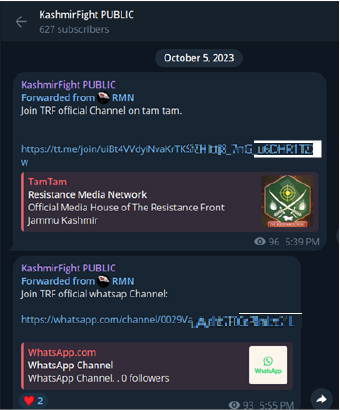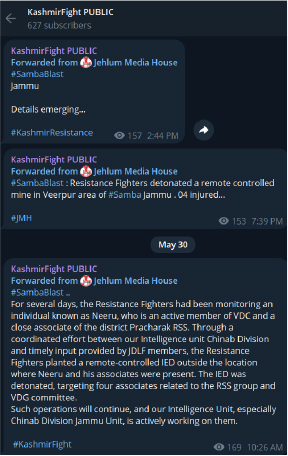



The research team at CYFIRMA initiated an investigation to uncover the latest online activities related to terrorism in Kashmir. This report highlights the efforts made by terrorist groups, utilizing digital platforms to spread propaganda and brainwashing content among the local Kashmiri population about their intentions and planned attacks, particularly through Telegram channels. The investigation also sheds light on the psychological operations (Psy Ops) conducted by these groups, which aim to manipulate public perception, spread fear, and destabilize the region. These Psy Ops are designed to maintain a heightened state of alarm and confusion, making it challenging for local authorities to maintain order and security.
In recent times, several media reports have concluded that terrorism in Kashmir has significantly reduced compared to previous years, with both foreign and local terrorist numbers in the Kashmir Valley decreasing to their lowest levels ever observed. However, following the abrogation of Article 370, there has been a noticeable resurgence of terrorist groups operating under new names, namely the Resistance Front (TRF) – run by Lashkar-e-Taiba (LeT) – and Kashmir Tigers, operated by the Jaish-e-Mohammed (JeM).
These groups have adapted to the digital age, using platforms like Telegram to release official statements and maximize their reach online. These channels frequently disseminate propaganda material following attacks and often criticize political events or government decisions in an attempt to justify their attacks and incite further division. This digital presence plays a crucial role for these terrorist organizations, allowing them to influence public perception and maintain their relevance in the region despite the reduced physical presence of militants.
Apart from Telegram, terrorist organizations have started using other platforms, however, Telegram remains their primary platform for engagement. These include:
Surprisingly, Chirpwire5 social media is being employed by Kashmir-based terrorist groups, which are used by extremist groups to release propaganda content, communicate securely, and coordinate action. Chirpwire is notably favored by al-Qaeda and has also been used by pro-ISIS groups, perhaps due to the encrypted nature of the platform, which also boasts features similar to mainstream social media apps.
Below is a screenshot of the Chirpwire profile from the TRF terrorist group, showing an update (which is also found on their Telegram channel).

This screenshot shows a Telegram post by KashmirFight, calling users to join channels on other platforms (such as WhatsApp and Tam-tam).

This screenshot shows the KashmirFight mouthpiece for TRF criticizing Narendra Modi and the G7 Summit on Mastodon:

On the same platform, KashmirFight threatens more attacks on the Jammu region:

The below shows information on the attack in the Jammu region:

The Telegram Channel is challenging Indian narratives relating to Kashmir using propaganda:

Another terror group, PAFF, released a statement following the attack on a bus carrying pilgrims in Reasi. The group expressed opposition to targeting pilgrims yet supported attacks on security forces, and suggested that the Jammu region might become part of the ongoing conflict:

Since the abrogation of Article 370, terror groups have increasingly utilized digital platforms to propagate their agendas. The quality of content and psychological operations (Psy Ops) on platforms like Telegram has significantly improved, enhancing their ability to spread fear and misinformation. These groups have employed digital channels to circulate attack details laced with propaganda, which has proven effective in their campaigns.
The recent attacks in Jammu and its surrounding regions highlight a significant internal threat to India. Terror groups used these incidents to spread propaganda material and maintain a heightened state of alarm, which has arguably complicated the efforts of security agencies. The sophisticated use of digital platforms for high-quality Psy Ops and propaganda is a growing concern, posing a major threat to the stability and security of the Jammu and Kashmir region. The continuous activity on these channels indicates that the threat to Jammu is not only persistent but also evolving, and terror groups such as these will find more platforms where they can host their propaganda machine. Jammu is a recent example of how terror groups propagate fear and conduct psychological operations (Psy Ops). This strategy extends across the entire Jammu and Kashmir region, with digital platforms being utilized for spreading propaganda material. In the future, these groups may develop more sophisticated and higher-quality content, making it increasingly difficult to counter their influence.
Terror groups find digital platforms highly convenient for reaching audiences across borders and influencing individuals, thereby, exacerbating the internal threat to India. These platforms keep the situation tense after attacks and use these incidents to conduct psychological operations (Psy Ops). Despite periodic bans, these groups quickly reactivate by creating new accounts. However, proper monitoring of these channels and accounts by the Indian government can help mitigate this and reduce fear among local citizens and tourists planning vacations in the valley.